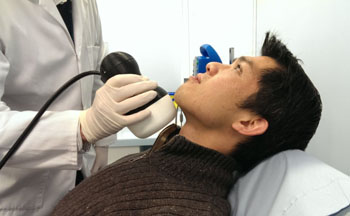Novel Molecular Imaging System Revealed at SNMMI 2016
By MedImaging International staff writers
Posted on 21 Jun 2016
A new portable hybrid molecular imaging system that combines optical and gamma imaging and can provide a multi-dimensional view of surface organs has been announced at the annual meeting of the Society of Nuclear Medicine and Molecular Imaging (SNMMI 2016).Posted on 21 Jun 2016
The imaging system provides clinicians with molecular data and an optical image of skin, eyes, or other surface organs in a single frame. The scintigraphy part of the system includes a gamma camera that can detect minute radioactive signals from a radionuclide.

Image: The mobile mini gamma ray camera being evaluated in the clinic (Photo courtesy of the University of Leicester).
The system was developed by researchers at the University of Leicester (Leicester, UK), and at the University of Nottingham (Nottingham, UK). The researchers presented the results of a clinical pilot study using the system in a scientific paper at the SNMMI 2016 meeting.
In the study the researchers performed standard molecular imaging procedures including thyroid or lymphatic system imaging. The researchers then used a 1.5 millimeter-thick scintillator to optimize the image resolution and reduce the acquisition time to less than five minutes. The results showed that the system was very effective for imaging thyroid and lymphatic tissue, and drainage from lacrimal glands, or tear ducts. The imaging system is still in the development stage.
Alan Perkins, PhD, Radiological Sciences, University of Nottingham, said, "This research covers the first patient results obtained with the hybrid optical-gamma camera developed in the UK at the Universities of Leicester and Nottingham. This scanner has hand-held potential and can be used in a variety of settings, including the outpatient clinic, patient bedside, operating theatre and intensive care unit."
Related Links:
University of Leicester
University of Nottingham














